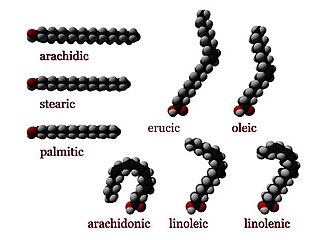Phenylacetate may refer to:
- Phenyl acetate, the ester of phenol and acetic acid
- The conjugate base of phenylacetic acid
Phenylacetate may refer to:

In chemistry, particularly in biochemistry, a fatty acid is a carboxylic acid with an aliphatic chain, which is either saturated or unsaturated. Most naturally occurring fatty acids have an unbranched chain of an even number of carbon atoms, from 4 to 28. Fatty acids are a major component of the lipids in some species such as microalgae but in some other organisms are not found in their standalone form, but instead exist as three main classes of esters: triglycerides, phospholipids, and cholesteryl esters. In any of these forms, fatty acids are both important dietary sources of fuel for animals and important structural components for cells.

In nutrition, biology, and chemistry, fat usually means any ester of fatty acids, or a mixture of such compounds, most commonly those that occur in living beings or in food.
IPA commonly refers to:
Neutral or neutrality may refer to:
Omega−3 fatty acids, also called Omega-3 oils, ω−3 fatty acids or n−3 fatty acids, are polyunsaturated fatty acids (PUFAs) characterized by the presence of a double bond, three atoms away from the terminal methyl group in their chemical structure. They are widely distributed in nature, being important constituents of animal lipid metabolism, and they play an important role in the human diet and in human physiology. The three types of omega−3 fatty acids involved in human physiology are α-linolenic acid (ALA), eicosapentaenoic acid (EPA) and docosahexaenoic acid (DHA). ALA can be found in plants, while DHA and EPA are found in algae and fish. Marine algae and phytoplankton are primary sources of omega−3 fatty acids. DHA and EPA accumulate in fish that eat these algae. Common sources of plant oils containing ALA include walnuts, edible seeds, and flaxseeds, while sources of EPA and DHA include fish and fish oils.

Sulfuric acid or sulphuric acid, known in antiquity as oil of vitriol, is a mineral acid composed of the elements sulfur, oxygen and hydrogen, with the molecular formula H2SO4. It is a colorless, odorless and viscous liquid that is miscible with water.
Synthesis or synthesize may also refer to:
Motif may refer to:

Calcium citrate is the calcium salt of citric acid. It is commonly used as a food additive (E333), usually as a preservative, but sometimes for flavor. In this sense, it is similar to sodium citrate. Calcium citrate is also found in some dietary calcium supplements. Calcium makes up 24.1% of calcium citrate (anhydrous) and 21.1% of calcium citrate (tetrahydrate) by mass. The tetrahydrate occurs in nature as the mineral Earlandite.
Coumaric acid is a phenolic derivative of cinnamic acid having a hydroxy group as substituent at one of the aromatic positions:
Linolenic acid is a type of naturally-occurring fatty acid. It can refer to either of two octadecatrienoic acids, or a mixture of the two. Linolenate is often found in vegetable oils; traditionally, such fatty acylates are reported as the fatty acids:
Monohydroxybenzoic acid may refer to any of three isomeric phenolic acids:
Gaa may refer to:
Sodium citrate may refer to any of the sodium salts of citric acid :
Dihydroxybenzoic acids (DHBA) are a type of phenolic acids.
Aminosalicylic acid can refer to any amino derivative of salicylic acid, such as:
Trihydroxybenzoic acid may refer to the following phenolic acids :
Dihydroxycinnamic acid may refer to several molecules with the molecular formula C9H8O4 including:
An acid anhydride is a type of chemical compound derived by the removal of water molecules from an acid.
The hydroxycarboxylic acid receptor (abbreviated HCA receptor and HCAR) family includes the following human proteins: